Can You Paint Over Wallpaper Glue? Pros, Cons & FAQ
-
Pete Ortiz
- Last updated:
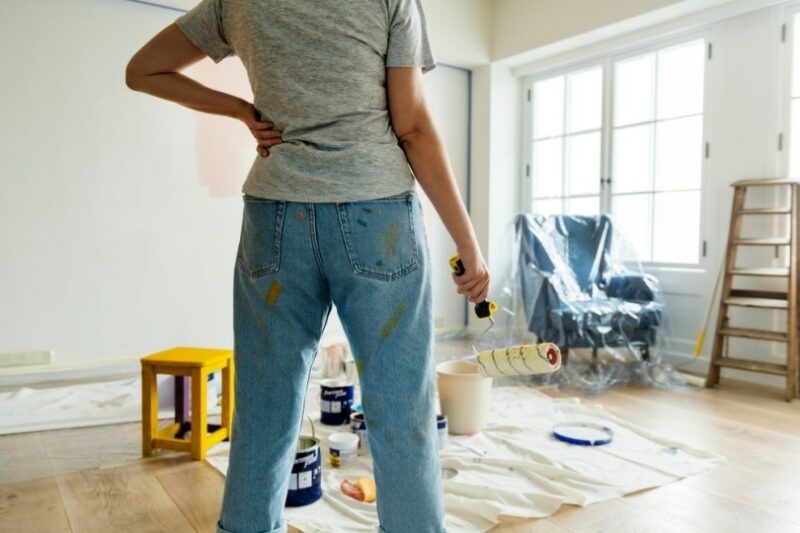
So, you have finally decided to remove that old, worn-out wallpaper off the walls and paint them instead? That’s great news, but what about the glue residue? Can it be painted over, or is that not a good idea? Technically, you can do that. However, we strongly recommend against it, as the paint won’t stick to the wall smoothly. Instead, you’ll have a wavy texture.
Why does that happen? The answer is simple: both paint and glue are water-based. Applying the paint to the wall launches a chemical reaction, bringing the glue “back to life”. So, how do you remove the glue from the wall, then? What are your options? Does primer work? Read on to find out!
What Is Wallpaper Glue? How Does It Work?
Specifically designed to “stick” wallpaper to walls, wallpaper glue is a combination of various chemical compounds. Often called the wall-covering adhesive, it needs to be mixed with water before application to get the right viscosity. Compared to regular glue, it has a significantly slower bonding speed¹. That gives you (the hanger) time to align the wallpaper properly and only glue it to the wall when it’s perfectly straight.
Oh, and depending on the size of the wallpaper roll, regular glue might not be strong enough to hold it. You’ll have to press it against the wall for a very long time, making your hands hurt. Besides, while this isn’t true for every single wallpaper glue type out there, most brands are waterproof (or, at least, resistant to high levels of humidity). So, while regular glue can be used, it’s not the ideal solution.
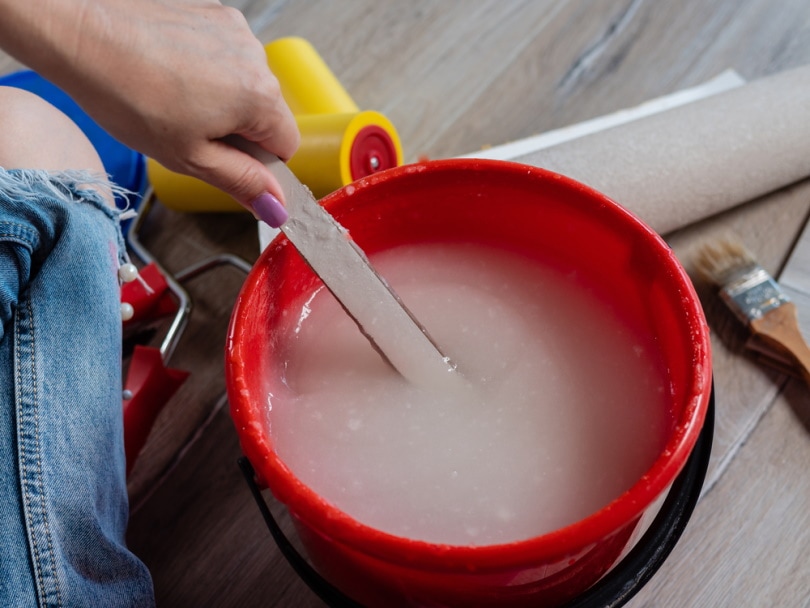
What Will Happen If You Paint Over It?
The short answer is nothing good. First, glue residue will prevent the paint from properly sticking to the surface. Second, the paint will have a chunky, clumpy texture. More importantly, no matter how expensive the paint is, it will have a hard time resisting humidity, dust, and grease. Most likely, it will start peeling off in a couple of years.
In the worst-case scenario, the paint will crack, leaving an ugly mark on the wall. The same is true for dust, oil, grease, and dirt, by the way. They prevent pretty much any liquid material from adhering to the wall. That’s why you need to get rid of the glue residue before you do any painting. Even if you apply multiple layers of premium-quality paint, that glue will still cause problems for you in the future.
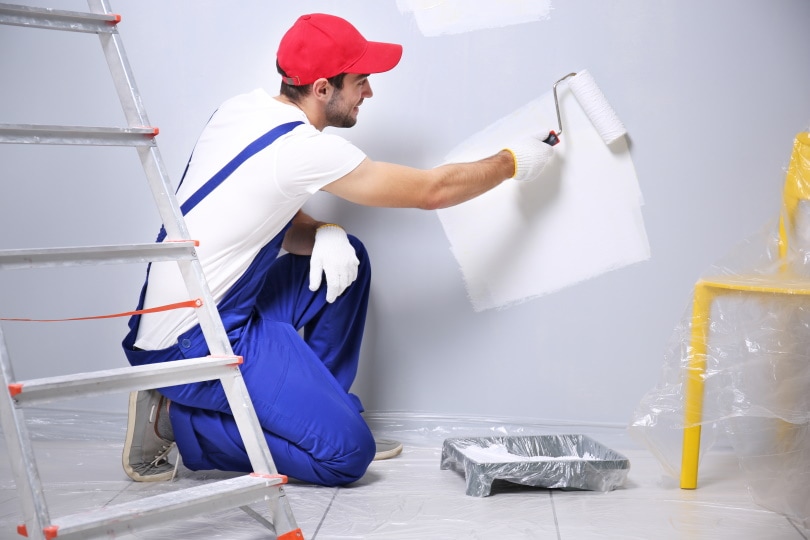
Removing Wallpaper Glue: Step-By-Step Guide
Alright, now that we’ve established that painting over wallpaper glue is a bad idea, it’s time to learn how to remove it. While the process can be a bit tiresome, if you follow our simple yet effective guide, it won’t take much time or effort. Start by washing the glue off. In most cases, that helps get rid of the adhesive residue. If that doesn’t help, grab a piece of sandpaper and deal with the glue that way.
- Order a pack of drop cloths. They’re available for cheap.
- Use them to cover the furniture, electric outlets, and gadgets/devices from the residue.
- Now it’s time to create a “home remedy” solution¹ against the glue.
- Add 1 teaspoon of regular dish soap and 1 cup of white vinegar into one gallon of hot water.
- Stir the mix lightly to turn it into a uniform liquid mass and avoid suds.
- Grab a sponge, dip it into the bucket, and wring it out. Next, gently rub the wall with it.
- Go slow and don’t press the sponge too hard against the wall or make it wet.
- To keep drips to a minimum, use a spray bottle instead.
- Remember: the warmer the water, the easier it will be to remove the glue.
- Oh, and don’t forget to put a pair of gloves on!
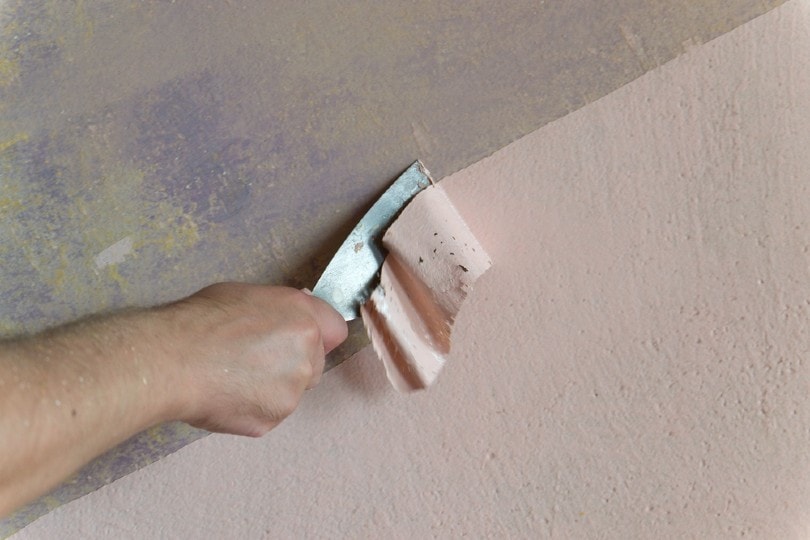
- Leave the sponge for now, and use a small knife with a wide blade (like a drywall knife¹) to scrape the glue off.
- Be quick about it—don’t let the glue dry up. Keep “attacking” the wall at a low angle so that you don’t damage it.
- All that scraping isn’t bearing results? Then it’s time to bring in the heavy artillery and sand the wall.
- Give the surface time to dry (12–24 hours, or even more) and sand it with 220 grit sandpaper.
- Fine-grit sandpaper has proven to be highly effective. If you have an oscillating sander, use it.
- Or, just do it the old-school way—with your hands. Again, be gentle.
That’s it! Check the wall with your fingers to see how smooth it is.
How About Using a Primer?
Still not ready to put some elbow grease into scraping the wallpaper glue off? Well, you could take a different route and use a primer to grind the walls. As long as it’s oil-based (NEVER use a water-based primer for this task) and you apply it accurately, the primer should be able to get the wall ready for the paint. Primers are great at concealing imperfections.¹
The name of the game here is multiple coats. Make them thin, but do at least 2–3 layers instead of one thick coat. And don’t rush it: give the paint some time to dry, and only then add the new layers. Also, take a long and hard look at the wall once the first coat has cured. Most likely, you’ll find white spots here and there. Pay extra attention to them when applying the second and third layers.
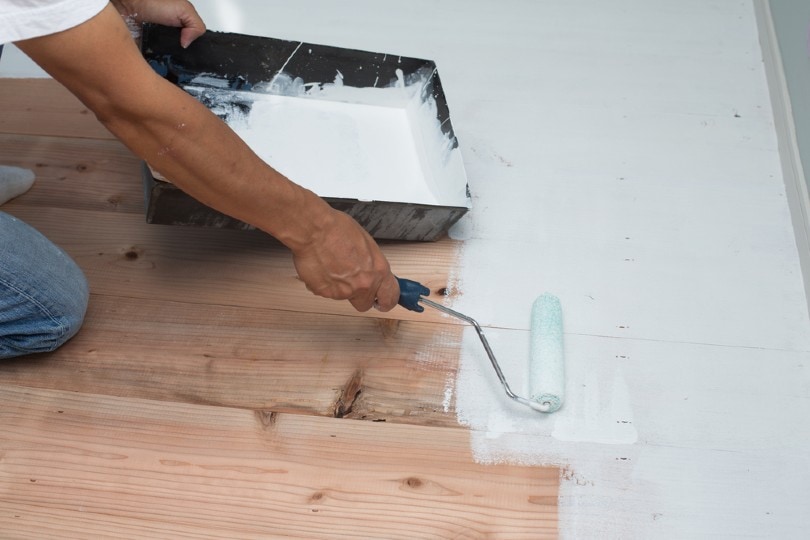
Skim Coat to the Rescue
Primers take very little effort to apply. Still, if you’re looking for an alternative, there’s always the option of skim coating the wall¹. Essentially, it’s drywall mud (also known as compound drywall). It specializes in giving the wall (or any other surface) a smooth, seamless look. It doesn’t cost much and can be applied with a paint roller or even a large-blade knife.
And if you want to get the best results, we recommend combining a primer with a skim coat. Start with the skim coat (add a healthy amount), top that with 1–2 coats of primer, and only then cover the wall with paint. This way, the new paint will last for up to 10 years, and the wall will look smoother than ever before.
Why Not Add New Wallpaper?
Yes, this is also an option. In many ways, it’s much easier and cheaper, as you won’t have to remove the glue or even the original wallpaper. Will it be as good as a polished, primed, and coated layer of paint? Not necessarily. But it will still look decent, and the new wallpaper will serve you for a long time.
Wallpaper vs Paint: A Detailed Comparison
Is paint really a better option than wallpaper? Or maybe it’s the other way around? Let’s take a quick look at what both options have to offer:
- The biggest advantage of paint over wallpaper is that it’s highly resistant to humidity and mold¹.
- Second, it’s much easier to apply: you won’t need an extra set of hands to help you out.
- Paint does a better job of covering imperfections on the wall, especially when you add an extra coat.
- When paired with a skim coat and primer, any paint looks super smooth.
- You can use paint in bathrooms and never worry about high humidity levels. With wallpapers, moisture is a huge problem.
- Paint is generally a more affordable product.
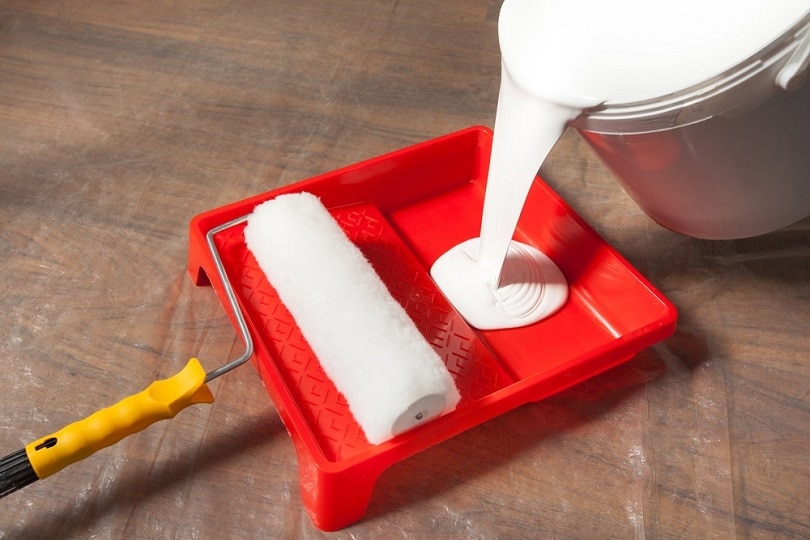
- Wallpapers last longer, which makes them a better investment in the long run. On average, they last for 10–15 years (versus 5–10 years if you go with premium paint).
- On top of that, they offer a lot more variety. Mainly, this applies to the textures and the color combinations. The sky’s the limit!
- You can choose whatever print you want and create custom, unique textures for your house.
- Next, wallpaper takes less time to dry, while certain paint brands need 2–3 days to dry (we’re talking about a single coat).
- Cheap paint products include chemicals that are harmful to humans and pets. The same can’t be said about wallpaper.
- Wallpapers are easier to clean from dirt, dust, and grease stains.
Conclusion
Glue residue on any surface is a disaster waiting to happen. No matter how old the house is or how thoroughly you were when removing the wallpaper, there will still be glue left on the walls! On its own, it won’t be a problem, but once you cover the walls with paint (water-based), the glue will get mixed up with it, causing trouble.
To avoid that, take a moment to remove every single bit of the adhesive or apply a primer plus skim coat to get the walls ready for the paint. As we learned today, that can be done easily. Follow our step-by-step instructions closely and make sure you have the necessary tools ready. That’s all there is to it!
See also:
- How to Make Glue Dry Faster (11 Methods)
- Can I Use CPVC Glue on PVC? What You Need To Know
- How to Hang Peel and Stick Wallpaper – 9 Expert Tips
- Confused Between Wallpaper And Paint? Choose Wisely
- WallpaperBoulevard – Wallpaper Vs. Paint: Which Is Better?
- Painting Over Wallpaper Glue? 10 Things You Need To Know
- How to Remove Wallpaper Glue in 5 Simple Steps
- TheSpruce – Can You Paint Over Wallpaper Glue?
- What Is Paint Primer, and What Does Primer Do?
- How to Choose Wallpaper Paste and Adhesives
- How to Remove Wallpaper Glue Residue
- Masterclass – How to Skim Coat a Wall
- Wikipedia – Wallpaper paste
Featured Image Credit: Whiteaster, Shutterstock
Contents


